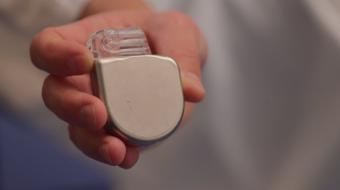Featured Videos
Premier Practitioners
All Videos
A defibrillator is used in patients who have either suffered a sudden cardiac death or at high risk for having a sudden cardiac death. Those that are at high risk are patients that have had significant damage to their heart as a result of heart attacks or arteries being blocked. Some patients with inherited heart muscle conditions or inherited electrical problems are at at risk for sudden death, and may use a defibrillator to prevent that.
Types of Defibrillators
You may see automated external defibrillators (AED) available in everywhere from golf courses to shopping malls, and they are relatively simple to use. You basically take out the patches, apply them and press the button. Generally, the device will decide whether to give the patient a shock, or whether they’ve just fainted and don’t need resuscitation.
An implantable cardiac defibrillator (ICD) is a miniature version of an AED, and is implanted under the collarbone of a patient and designed with all of the pacemaker capabilities. An implantable cardiac defibrillator has the ability to identify a lethal heart rhythm such as a tachycardia or ventricular fibrillation, and apply therapies to break that rhythm to prevent sudden cardiac death.
What to Expect During the ICD Procedure
The procedure to implant an ICD usually involves a cardiologist and in some cases, an electrophysiologist. The device stands by to resuscitate the patient if a sudden unexpected electrical event occurs. This is a lifesaving option for patients who are at high risk of suffering a sudden cardiac death, however, it’s a complex decision that involves both the patient and the healthcare team.
The device is placed under conscious sedation rather than a general anesthetic. Under local anesthetic, the surgeon will make a pocket is under the skin, place the wires in the vein into the heart, connect the wires to the device and close the incision with dissolvable sutures. Most patients are discharged the same day.
There’s a small risk of infection or that the wires of the implantable cardiac defibrillator may need to be plugged back into place. Following the ICD procedure, patients are restricted from driving for about a week. Patients who have implanted devices generally lead very normal lives. There are no restrictions on using microwaves or cell phones, and patients are able to travel.
An implantable cardioverter-defibrillator or automated implantable cardioverter defibrillator is a device implantable inside the body, able to perform cardioversion, defibrillation, and pacing of the heart. The device is therefore capable of correcting most life-threatening cardiac arrhythmias. A local Cardiologist can help you with a defibrillator.





